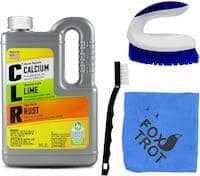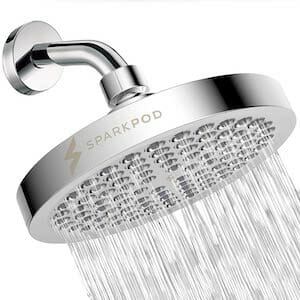There are not many things more frustrating than hopping in the shower only to experience a soft dribble of water streaming down from the showerhead. While low water pressure is a great way to save water, it can also make showering an arduous process. Because of this, many people choose to increase their water pressure, allowing them to take quicker showers.
Can I increase water pressure in a shower? Yes, while your water pressure is primarily dictated by how your plumbing is routed to the shower, there are several ways you can manually increase the water pressure in your shower. These solutions range from simply cleaning the showerhead to adjusting the settings on your hot water heater and more.
In this post, we will share several ways to easily increase the water pressure in your shower. Whether you are new to your home or simply noticing a decrease in your water pressure, you are sure to find a solution to improve your shower situation.
10 Easy Ways to Increase Water Pressure in A Shower
You may be under the impression that low water pressure is just something you have to deal with. While your home’s plumbing does have an impact on the water pressure that comes through your shower head, there are several steps you can take to improve your shower’s water pressure.
| Method | Description |
|---|---|
| 1. Clean the showerhead | Over time, mineral deposits can build up in the showerhead and reduce water flow. Remove the showerhead and soak it in a mixture of water and vinegar to dissolve the buildup. Rinse thoroughly and reattach it. |
| 2. Check the water pressure | Contact your water company or a plumber to determine the water pressure in your home. If it’s below 40 psi, it may be the cause of low water pressure in your shower. |
| 3. Remove flow restrictor | Some showerheads have a flow restrictor installed to reduce water usage. Removing it can increase the water pressure. However, this may increase water consumption and utility bills. |
| 4. Replace the showerhead | If cleaning the showerhead or removing the flow restrictor doesn’t work, consider replacing the showerhead with a high-pressure model. These showerheads have smaller holes and create a more forceful water stream. |
| 5. Install a pressure booster pump | A pressure booster pump can be installed on your water line to increase water pressure throughout your home. This is a more expensive option, but it can improve water pressure in your shower and other areas of your home. |
| 6. Check for leaks | Check for any leaks in your plumbing system, as this can reduce water pressure. If you find a leak, contact a plumber to repair it. |
| 7. Check the main shut-off valve | The main shut-off valve controls the water flow to your home. If it’s partially closed or damaged, it can reduce water pressure. Make sure the valve is fully open and functioning properly. |
| 8. Flush Your Hot Water Heater | One home maintenance task that many homeowners forget is flushing the hot water tank. Water heaters become clogged by sediment and debris that can make its way into the pipes. |
| 9. Try Showering at a Different Time | Try showering at alternative times such as in the afternoon or evening to eliminate or confirm this as a cause of the problem. |
| 10. Adjust the Settings On Your Shower Head | Although you likely do not frequently adjust the settings on your showerhead, they may shift over time. |
It’s important to note that some of these methods may require the assistance of a professional plumber, es
What Causes Low Water Pressure?
There are several reasons you could be experiencing low water pressure in your shower. Most often, low water pressure is caused by a setting either with your hot water heater, your plumbing, or the showerhead itself. However, low water pressure can also be caused by the inefficient routing of your home’s plumbing, something that requires intensive intervention.
Tips for Increasing Your Shower’s Water Pressure
If you are experiencing low water pressure in your shower, we recommend systematically working your way through these tips in order to find a solution. In some situations, you may benefit from contacting a plumbing professional to assess the situation.

1. Clean Your Shower Head
By far the easiest way to increase your water pressure in your shower is to clean your shower head. Mold, mildew, calcium, rust and water sediments such as limescale or mineral deposits can cause the shower head to become clogged. There are many ways to remove the buildup from your shower head.
To start, remove the top of the showerhead and detach any pieces that are easily removed. Carefully clean each piece to remove any visible sediment. There are tools designed specifically for this purpose and cleaners that can help make the job easier.
Shower Head Cleaner
If there is still visible buildup after your initial cleaning, allow the showerhead to soak immersed in white vinegar overnight. Once you reassemble the shower head, run hot water through your shower to flush out any remaining debris.
2. Check the Water Pressure
Contact your water company or a plumber to determine the water pressure in your home. If it’s below 40 psi, it may be the cause of low water pressure in your shower.
3. Remove the Shower Head Flow Restrictor
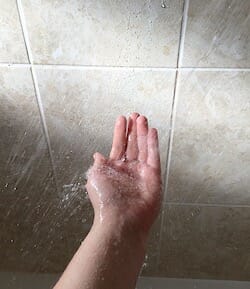 Many new showerheads are equipped with a flow restrictor. While this apparatus is designed to save money on your water bills, it can also prevent you from reaching the increased water pressure that you desire. Flow restrictors perform perfectly in many homes. However, if you live in an older home or a home with low water pressure due to ineffective plumbing, a flow restrictor will only create unnecessary issues.
Many new showerheads are equipped with a flow restrictor. While this apparatus is designed to save money on your water bills, it can also prevent you from reaching the increased water pressure that you desire. Flow restrictors perform perfectly in many homes. However, if you live in an older home or a home with low water pressure due to ineffective plumbing, a flow restrictor will only create unnecessary issues.
If your showerhead comes equipped with a flow restrictor, the user’s manual will include detailed instructions on how to remove this device. If you are anything like us, you do not have the user’s manual to your showerhead. Do not fear! User’s manuals are easily found online for a majority of models.
How to Remove the Flow Restrictor
1. Remove the shower head.
2. Look inside the connector nut for the rubber seal.
3. Look for a piece of plastic with a hole or holes in it.
4. Remove the plastic with some tweezers or a pair of pliers.
5. Replace the rubber seal and reinstall the shower head.
4. Replace the Showerhead
Many homes still have basic showerheads. With a small surface area and minimal room for adjustments, these basic models do not often allow you to achieve the water pressure you desire. Luckily, showerheads are an inexpensive solution to low water pressure!
Replacing your shower head is not difficult and a newer model will provide you with greater room for customization of water pressure.
5. Install a Shower Pump
Finally, if none of the tips mentioned above improve the water pressure in your shower, you may need to consider a more aggressive approach. While installing a shower pump is certainly more expensive than the other tips mentioned above, it is far less expensive than rerouting your plumbing.
Installing a shower pump is not a DIY project for most individuals. We recommend that you contact your local plumber before investing in this piece of equipment as it may not be worth the investment for your situation.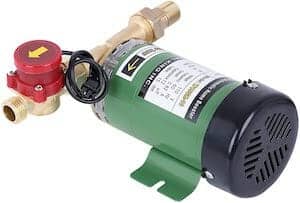
6. Look for Water Leaks
A sudden decrease in water pressure can be a warning sign of water leaks! It is important to check for water leaks along the system as they can lead to significant damage. Begin at the shower and work backward, following the plumbing back towards the main supply. If you notice any leaks, shut off the water valve immediately and contact a plumbing professional.
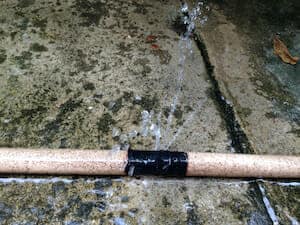
7. Check the Main Shut-Off Valve
If you have recently moved into your home, whether new or old, your main shut-off valve may not be fully open. You can find the water shut-off valve wherever the main system is located. Oftentimes this is in the basement or garage. Verify that the shut-off valve is set to the open position as that will impact the water pressure you can achieve.
8. Flush Your Hot Water Heater
One home maintenance task that many homeowners forget is flushing the hot water tank. Water heaters become clogged by sediment and debris that can make its way into the pipes. Draining your water heater and flushing the lines will require a few hours of work but it is something you should do regularly to maintain your system.
This process is rather straightforward and instructions for your system can be found in the user’s manual, often attached to the outside of the unit.
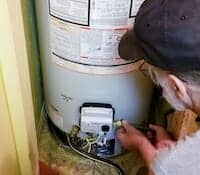 9. Try Showering at a Different Time
9. Try Showering at a Different Time
Are you experiencing the weakest water pressure in the early morning hours? If you live in close proximity to your neighbors, this could be part of the issue! Try showering at alternative times such as in the afternoon or evening to verify if this is the cause. People who live in apartment complexes or condos are most likely to experience low water pressure because of their neighbors.
10. Adjust the Settings On Your Shower Head
Although you likely do not frequently adjust the settings on your showerhead, they may shift over time. This can leave you with the false impression that your water pressure has decreased. While the shower is running, try adjusting the settings to see if you can achieve a higher water pressure.
Can a Plumber Increase the Water Pressure In a Shower?
In most cases, a homeowner will be able to take steps to increase the water pressure to their shower. However, sometimes a plumber should be called to investigate the cause of low water pressure. There may be times when the only solution to increasing your water pressure is to reroute your plumbing more efficiently.
This is an expensive and invasive endeavor, however, and is something that you should carefully consider. If you live in an old home or envision yourself living in your home for decades, this may be a worthwhile investment.
Additionally, a plumber can look for signs of water leaks, clogged pipes, and other issues. These things may not be apparent to the untrained eye. The bottom line is this, if you have worked through the more simple approaches to improving your water pressure, it may be worthwhile to contact a plumbing professional.
Does High Water Pressure Really Matter?
For most people, high water pressure is simply a matter of preference. However, we use our showers more regularly than many other areas of the home. Showers not only provide us with an opportunity to maintain our hygiene. They can also be a calm refuge after a long day.
If you are not able to enjoy your daily shower due to poor water pressure, it is definitely worth it to look for ways to improve your situation. Not only will this make your showering more enjoyable but can also save water by allowing you to shower efficiently. We hope these simple tips will help you achieve the water pressure of your dreams!
Thank you for reading! You can find more plumbing tips from experts here.

